Critical Analysis of Innovation and Technology Transfer Management
VerifiedAdded on 2020/02/03
|23
|3782
|33
Report
AI Summary
This report delves into the critical aspects of managing innovation and technology transfer as a core business process. It begins with an introduction to the importance of innovation and technology in the 21st century, highlighting its impact on various sectors and the UK government's recognition of its significance. The report then provides an in-depth analysis of innovation management, exploring different dimensions, degrees, and phases, including the innovation loop and various types of innovation. It also critically evaluates the challenges in building and managing an innovative organization, discussing internal factors such as employee empowerment, strategic planning, and risk aversion. Furthermore, the report examines key attributes for capturing learning from innovation and technology transfer, emphasizing the roles of leadership, organizational structure, and team work in fostering an innovative environment. Finally, the report appraises theories of managing innovation and technology transfer in the 21st century, including strategic planning and contingency models. This comprehensive analysis provides valuable insights into the complexities and strategies involved in driving innovation and technology transfer within businesses.
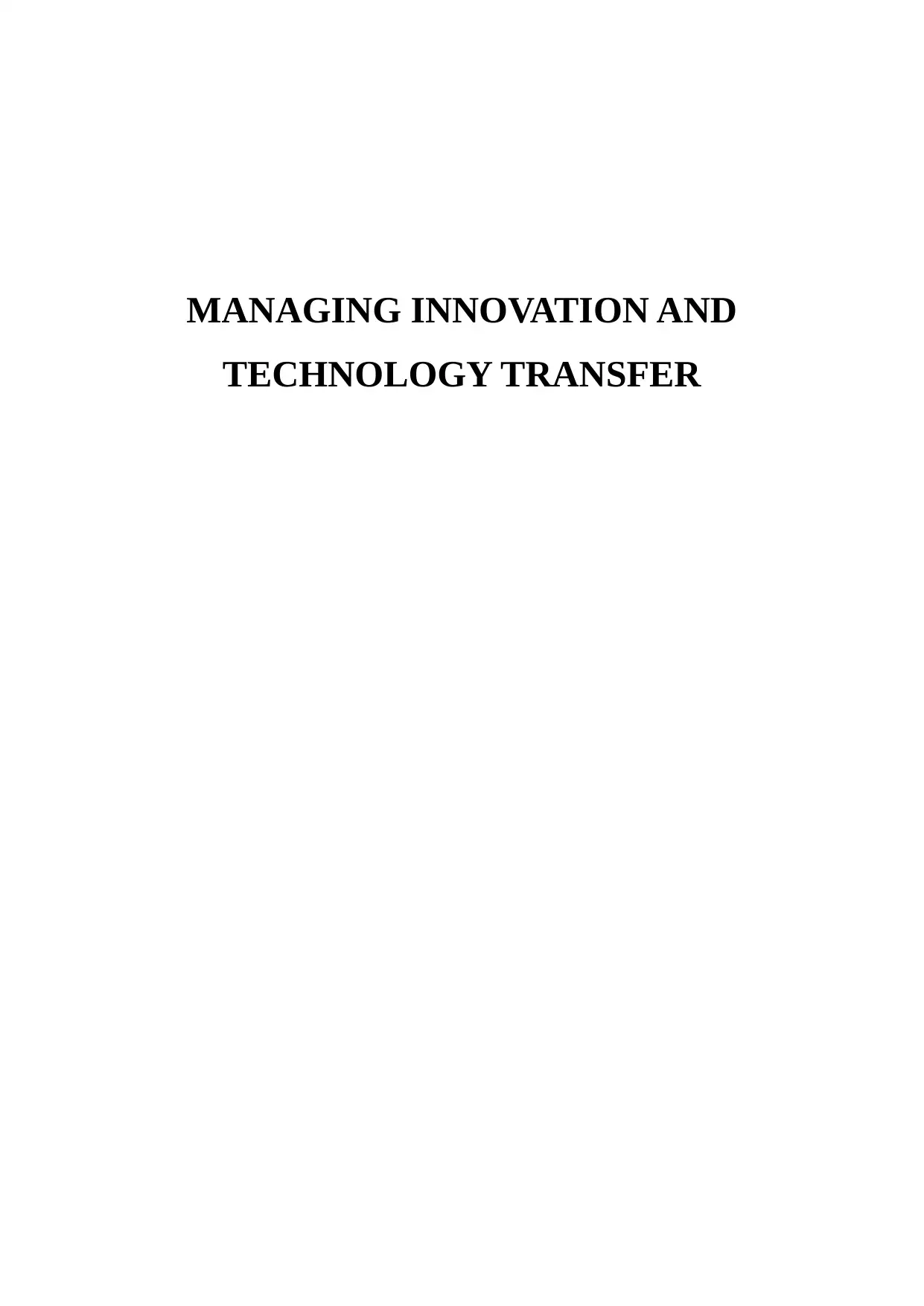
MANAGING INNOVATION AND
TECHNOLOGY TRANSFER
TECHNOLOGY TRANSFER
Paraphrase This Document
Need a fresh take? Get an instant paraphrase of this document with our AI Paraphraser
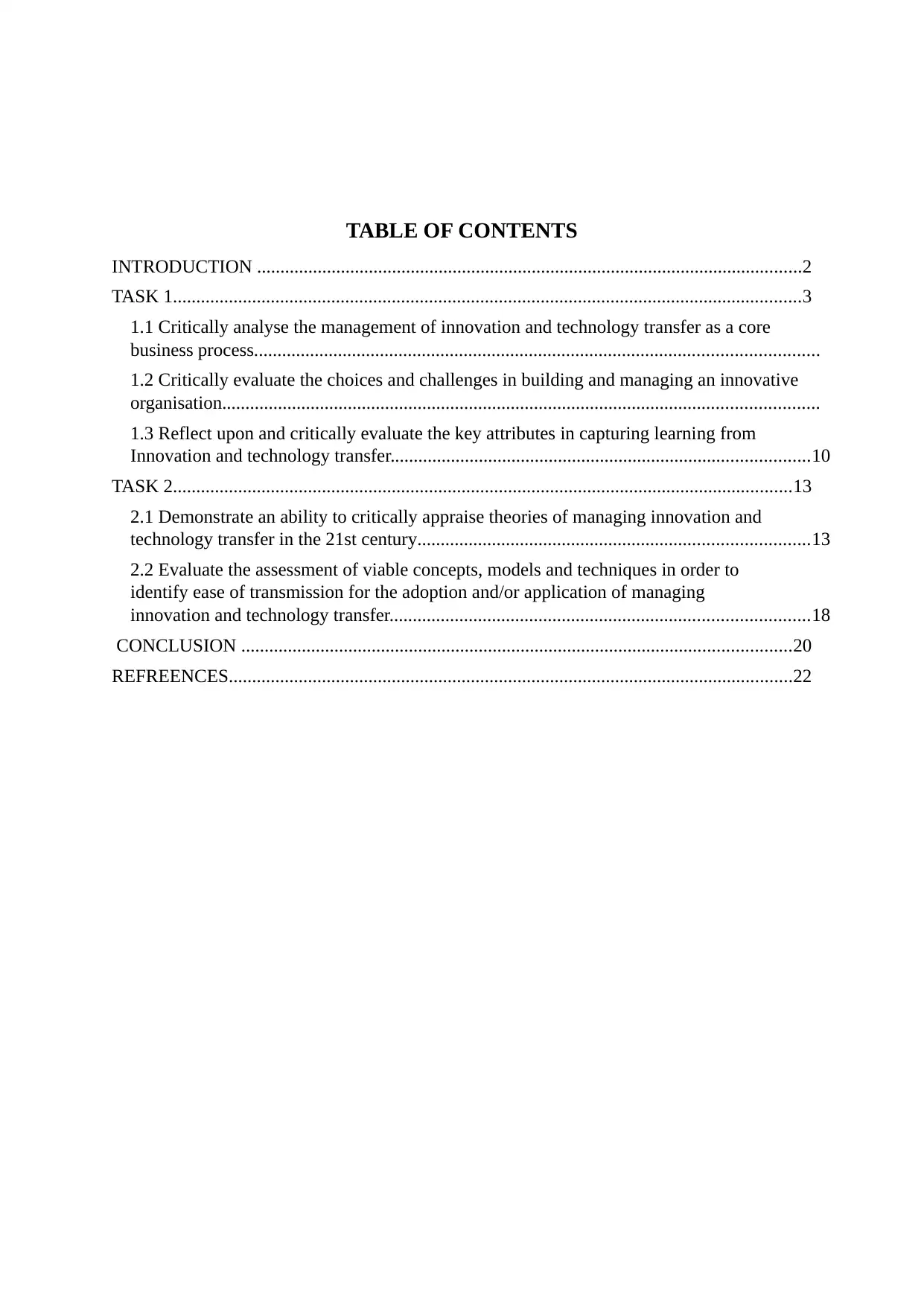
TABLE OF CONTENTS
INTRODUCTION .....................................................................................................................2
TASK 1.......................................................................................................................................3
1.1 Critically analyse the management of innovation and technology transfer as a core
business process.........................................................................................................................
1.2 Critically evaluate the choices and challenges in building and managing an innovative
organisation................................................................................................................................
1.3 Reflect upon and critically evaluate the key attributes in capturing learning from
Innovation and technology transfer..........................................................................................10
TASK 2.....................................................................................................................................13
2.1 Demonstrate an ability to critically appraise theories of managing innovation and
technology transfer in the 21st century....................................................................................13
2.2 Evaluate the assessment of viable concepts, models and techniques in order to
identify ease of transmission for the adoption and/or application of managing
innovation and technology transfer..........................................................................................18
CONCLUSION ......................................................................................................................20
REFREENCES.........................................................................................................................22
INTRODUCTION .....................................................................................................................2
TASK 1.......................................................................................................................................3
1.1 Critically analyse the management of innovation and technology transfer as a core
business process.........................................................................................................................
1.2 Critically evaluate the choices and challenges in building and managing an innovative
organisation................................................................................................................................
1.3 Reflect upon and critically evaluate the key attributes in capturing learning from
Innovation and technology transfer..........................................................................................10
TASK 2.....................................................................................................................................13
2.1 Demonstrate an ability to critically appraise theories of managing innovation and
technology transfer in the 21st century....................................................................................13
2.2 Evaluate the assessment of viable concepts, models and techniques in order to
identify ease of transmission for the adoption and/or application of managing
innovation and technology transfer..........................................................................................18
CONCLUSION ......................................................................................................................20
REFREENCES.........................................................................................................................22
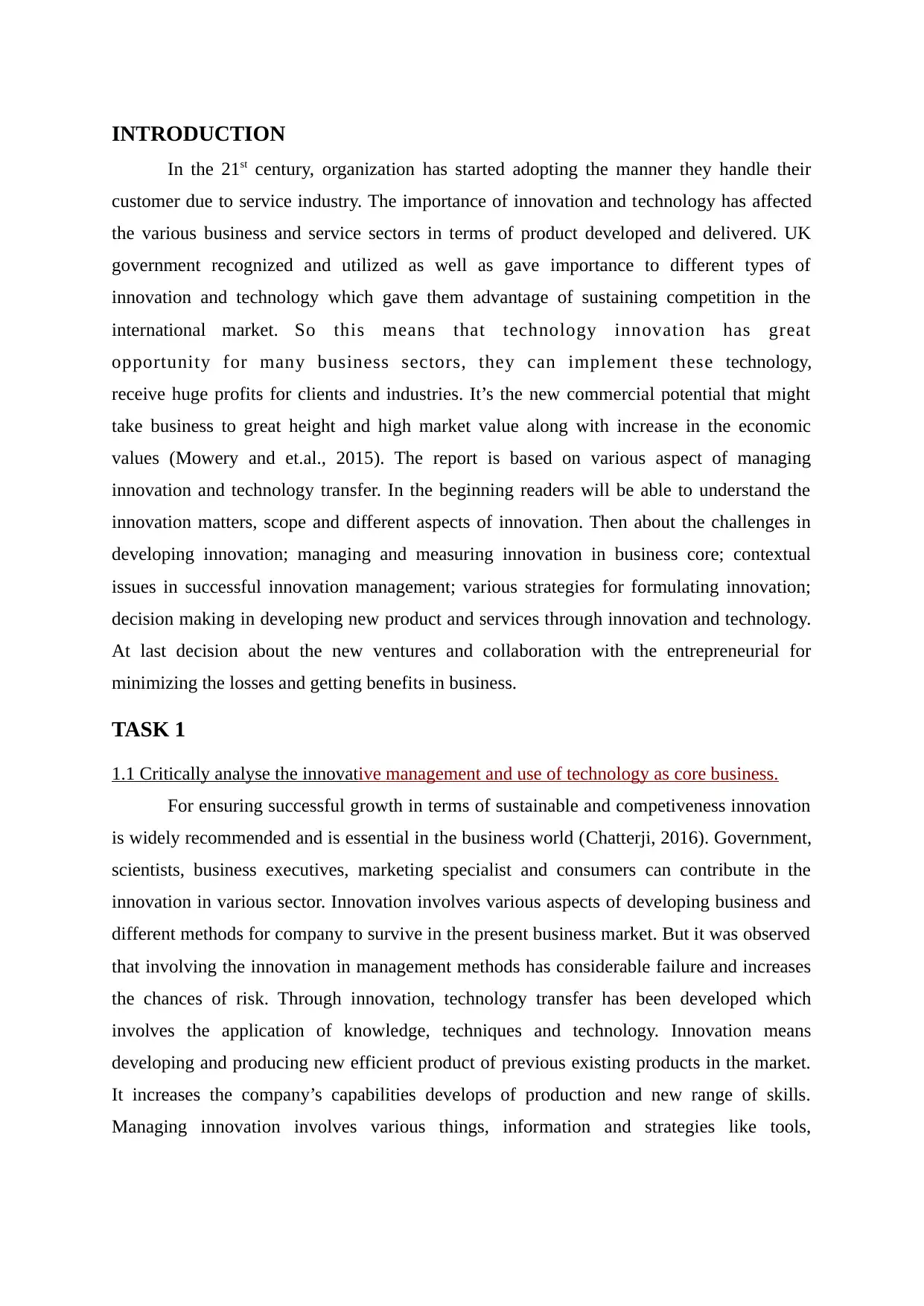
INTRODUCTION
In the 21st century, organization has started adopting the manner they handle their
customer due to service industry. The importance of innovation and technology has affected
the various business and service sectors in terms of product developed and delivered. UK
government recognized and utilized as well as gave importance to different types of
innovation and technology which gave them advantage of sustaining competition in the
international market. So this means that technology innovation has great
opportunity for many business sectors, they can implement these technology,
receive huge profits for clients and industries. It’s the new commercial potential that might
take business to great height and high market value along with increase in the economic
values (Mowery and et.al., 2015). The report is based on various aspect of managing
innovation and technology transfer. In the beginning readers will be able to understand the
innovation matters, scope and different aspects of innovation. Then about the challenges in
developing innovation; managing and measuring innovation in business core; contextual
issues in successful innovation management; various strategies for formulating innovation;
decision making in developing new product and services through innovation and technology.
At last decision about the new ventures and collaboration with the entrepreneurial for
minimizing the losses and getting benefits in business.
TASK 1
1.1 Critically analyse the innovative management and use of technology as core business.
For ensuring successful growth in terms of sustainable and competiveness innovation
is widely recommended and is essential in the business world (Chatterji, 2016). Government,
scientists, business executives, marketing specialist and consumers can contribute in the
innovation in various sector. Innovation involves various aspects of developing business and
different methods for company to survive in the present business market. But it was observed
that involving the innovation in management methods has considerable failure and increases
the chances of risk. Through innovation, technology transfer has been developed which
involves the application of knowledge, techniques and technology. Innovation means
developing and producing new efficient product of previous existing products in the market.
It increases the company’s capabilities develops of production and new range of skills.
Managing innovation involves various things, information and strategies like tools,
In the 21st century, organization has started adopting the manner they handle their
customer due to service industry. The importance of innovation and technology has affected
the various business and service sectors in terms of product developed and delivered. UK
government recognized and utilized as well as gave importance to different types of
innovation and technology which gave them advantage of sustaining competition in the
international market. So this means that technology innovation has great
opportunity for many business sectors, they can implement these technology,
receive huge profits for clients and industries. It’s the new commercial potential that might
take business to great height and high market value along with increase in the economic
values (Mowery and et.al., 2015). The report is based on various aspect of managing
innovation and technology transfer. In the beginning readers will be able to understand the
innovation matters, scope and different aspects of innovation. Then about the challenges in
developing innovation; managing and measuring innovation in business core; contextual
issues in successful innovation management; various strategies for formulating innovation;
decision making in developing new product and services through innovation and technology.
At last decision about the new ventures and collaboration with the entrepreneurial for
minimizing the losses and getting benefits in business.
TASK 1
1.1 Critically analyse the innovative management and use of technology as core business.
For ensuring successful growth in terms of sustainable and competiveness innovation
is widely recommended and is essential in the business world (Chatterji, 2016). Government,
scientists, business executives, marketing specialist and consumers can contribute in the
innovation in various sector. Innovation involves various aspects of developing business and
different methods for company to survive in the present business market. But it was observed
that involving the innovation in management methods has considerable failure and increases
the chances of risk. Through innovation, technology transfer has been developed which
involves the application of knowledge, techniques and technology. Innovation means
developing and producing new efficient product of previous existing products in the market.
It increases the company’s capabilities develops of production and new range of skills.
Managing innovation involves various things, information and strategies like tools,
⊘ This is a preview!⊘
Do you want full access?
Subscribe today to unlock all pages.

Trusted by 1+ million students worldwide
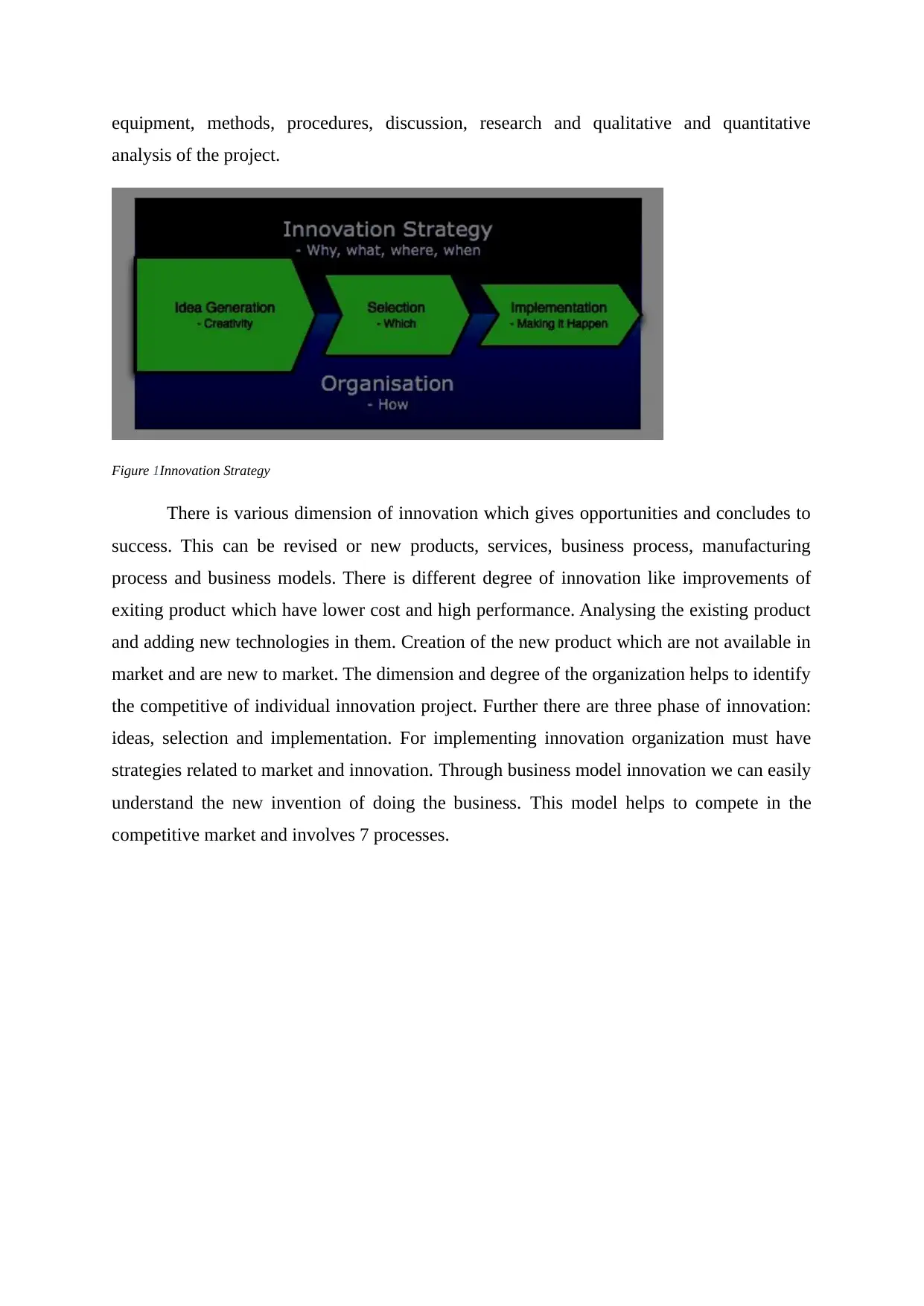
equipment, methods, procedures, discussion, research and qualitative and quantitative
analysis of the project.
Figure 1Innovation Strategy
There is various dimension of innovation which gives opportunities and concludes to
success. This can be revised or new products, services, business process, manufacturing
process and business models. There is different degree of innovation like improvements of
exiting product which have lower cost and high performance. Analysing the existing product
and adding new technologies in them. Creation of the new product which are not available in
market and are new to market. The dimension and degree of the organization helps to identify
the competitive of individual innovation project. Further there are three phase of innovation:
ideas, selection and implementation. For implementing innovation organization must have
strategies related to market and innovation. Through business model innovation we can easily
understand the new invention of doing the business. This model helps to compete in the
competitive market and involves 7 processes.
analysis of the project.
Figure 1Innovation Strategy
There is various dimension of innovation which gives opportunities and concludes to
success. This can be revised or new products, services, business process, manufacturing
process and business models. There is different degree of innovation like improvements of
exiting product which have lower cost and high performance. Analysing the existing product
and adding new technologies in them. Creation of the new product which are not available in
market and are new to market. The dimension and degree of the organization helps to identify
the competitive of individual innovation project. Further there are three phase of innovation:
ideas, selection and implementation. For implementing innovation organization must have
strategies related to market and innovation. Through business model innovation we can easily
understand the new invention of doing the business. This model helps to compete in the
competitive market and involves 7 processes.
Paraphrase This Document
Need a fresh take? Get an instant paraphrase of this document with our AI Paraphraser
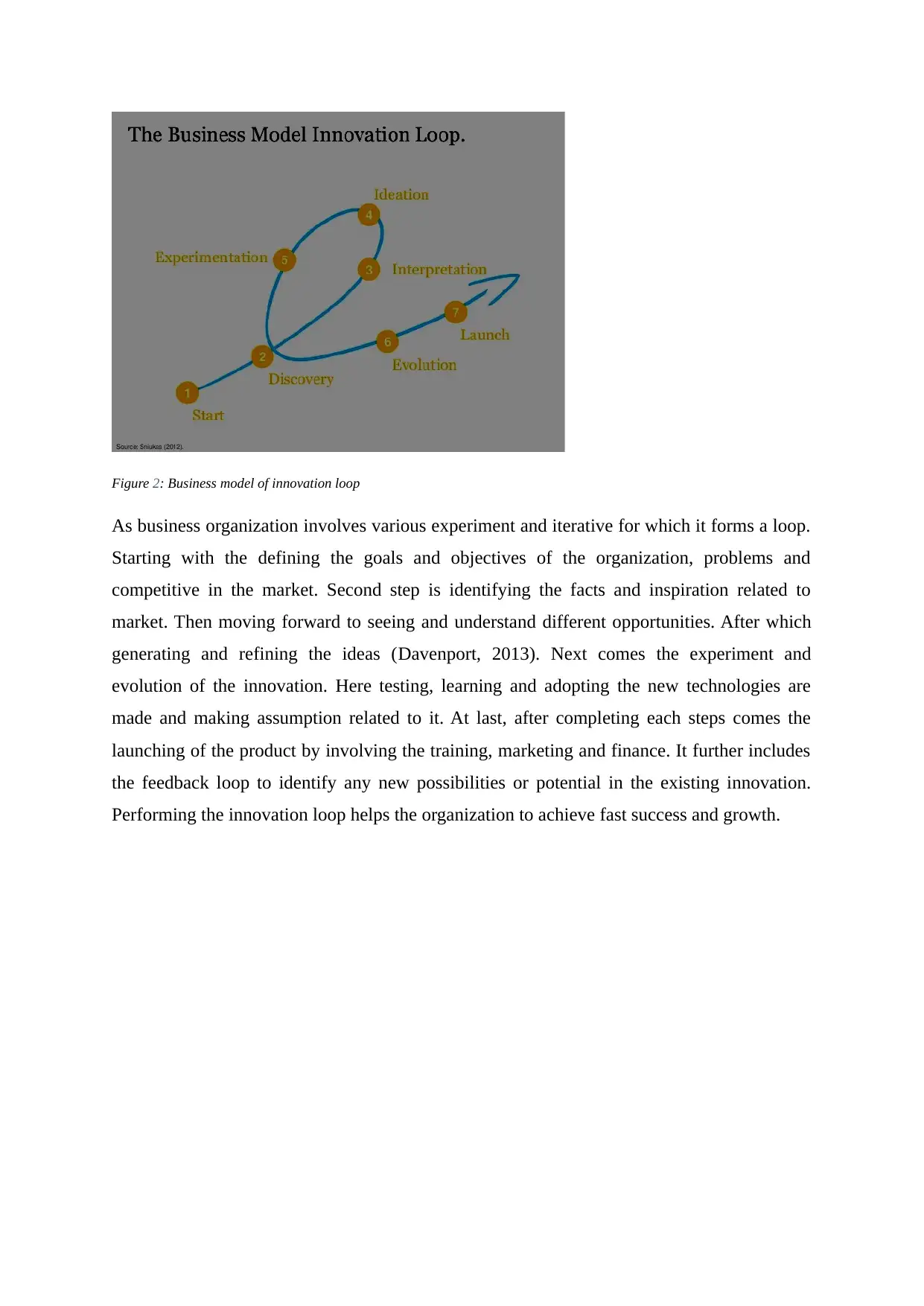
Figure 2: Business model of innovation loop
As business organization involves various experiment and iterative for which it forms a loop.
Starting with the defining the goals and objectives of the organization, problems and
competitive in the market. Second step is identifying the facts and inspiration related to
market. Then moving forward to seeing and understand different opportunities. After which
generating and refining the ideas (Davenport, 2013). Next comes the experiment and
evolution of the innovation. Here testing, learning and adopting the new technologies are
made and making assumption related to it. At last, after completing each steps comes the
launching of the product by involving the training, marketing and finance. It further includes
the feedback loop to identify any new possibilities or potential in the existing innovation.
Performing the innovation loop helps the organization to achieve fast success and growth.
As business organization involves various experiment and iterative for which it forms a loop.
Starting with the defining the goals and objectives of the organization, problems and
competitive in the market. Second step is identifying the facts and inspiration related to
market. Then moving forward to seeing and understand different opportunities. After which
generating and refining the ideas (Davenport, 2013). Next comes the experiment and
evolution of the innovation. Here testing, learning and adopting the new technologies are
made and making assumption related to it. At last, after completing each steps comes the
launching of the product by involving the training, marketing and finance. It further includes
the feedback loop to identify any new possibilities or potential in the existing innovation.
Performing the innovation loop helps the organization to achieve fast success and growth.
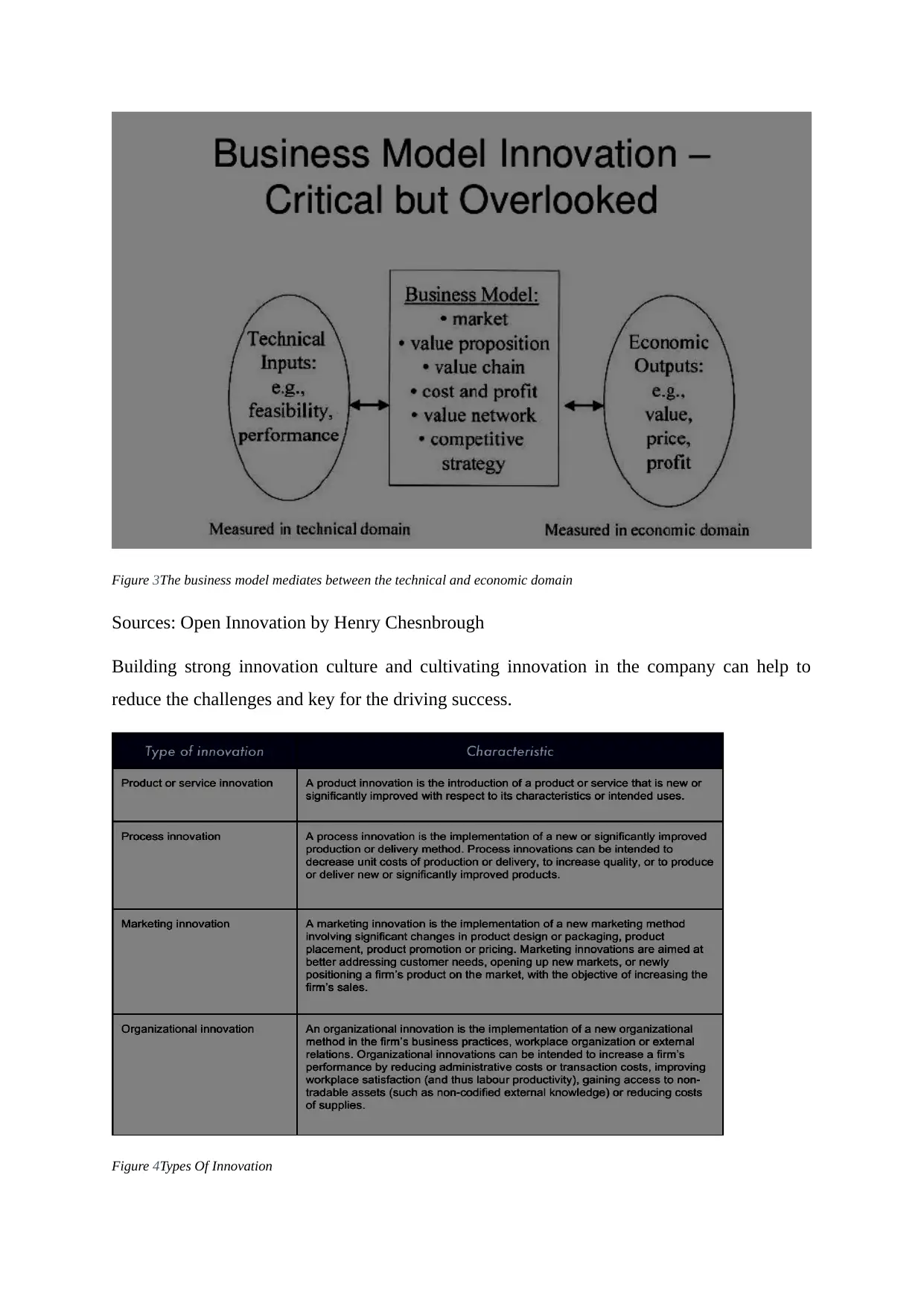
Figure 3The business model mediates between the technical and economic domain
Sources: Open Innovation by Henry Chesnbrough
Building strong innovation culture and cultivating innovation in the company can help to
reduce the challenges and key for the driving success.
Figure 4Types Of Innovation
Sources: Open Innovation by Henry Chesnbrough
Building strong innovation culture and cultivating innovation in the company can help to
reduce the challenges and key for the driving success.
Figure 4Types Of Innovation
⊘ This is a preview!⊘
Do you want full access?
Subscribe today to unlock all pages.

Trusted by 1+ million students worldwide
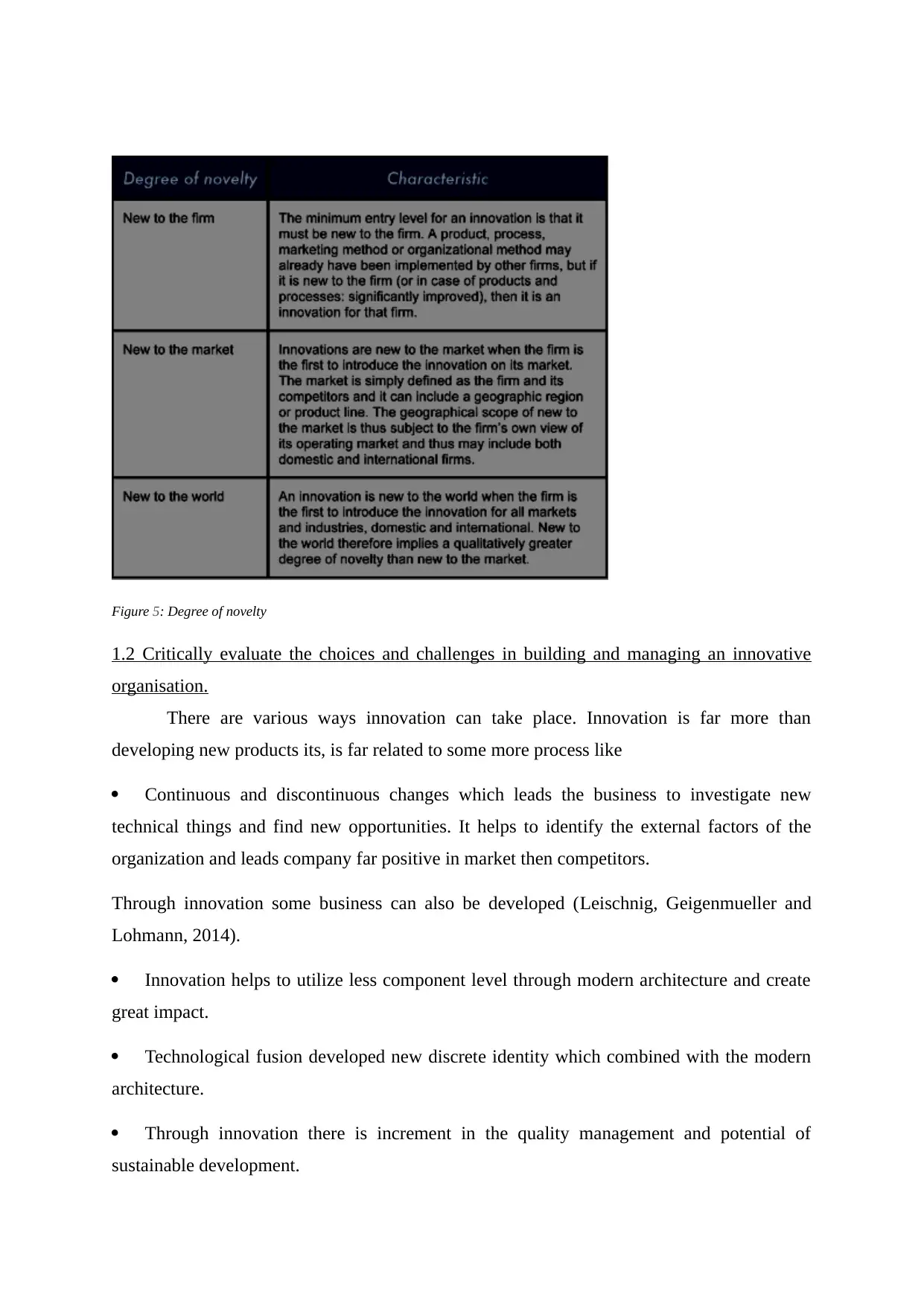
Figure 5: Degree of novelty
1.2 Critically evaluate the choices and challenges in building and managing an innovative
organisation.
There are various ways innovation can take place. Innovation is far more than
developing new products its, is far related to some more process like
Continuous and discontinuous changes which leads the business to investigate new
technical things and find new opportunities. It helps to identify the external factors of the
organization and leads company far positive in market then competitors.
Through innovation some business can also be developed (Leischnig, Geigenmueller and
Lohmann, 2014).
Innovation helps to utilize less component level through modern architecture and create
great impact.
Technological fusion developed new discrete identity which combined with the modern
architecture.
Through innovation there is increment in the quality management and potential of
sustainable development.
1.2 Critically evaluate the choices and challenges in building and managing an innovative
organisation.
There are various ways innovation can take place. Innovation is far more than
developing new products its, is far related to some more process like
Continuous and discontinuous changes which leads the business to investigate new
technical things and find new opportunities. It helps to identify the external factors of the
organization and leads company far positive in market then competitors.
Through innovation some business can also be developed (Leischnig, Geigenmueller and
Lohmann, 2014).
Innovation helps to utilize less component level through modern architecture and create
great impact.
Technological fusion developed new discrete identity which combined with the modern
architecture.
Through innovation there is increment in the quality management and potential of
sustainable development.
Paraphrase This Document
Need a fresh take? Get an instant paraphrase of this document with our AI Paraphraser
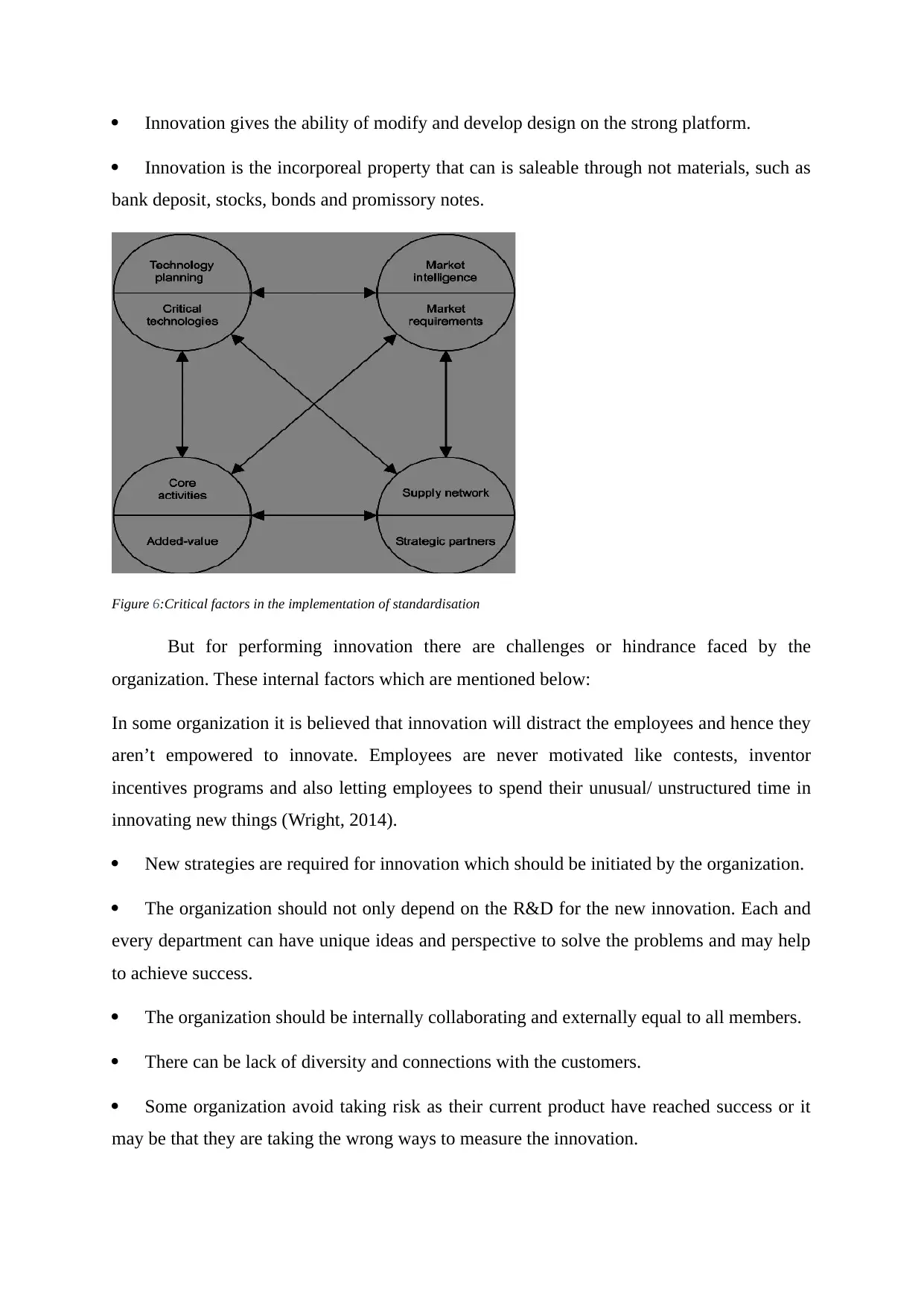
Innovation gives the ability of modify and develop design on the strong platform.
Innovation is the incorporeal property that can is saleable through not materials, such as
bank deposit, stocks, bonds and promissory notes.
Figure 6:Critical factors in the implementation of standardisation
But for performing innovation there are challenges or hindrance faced by the
organization. These internal factors which are mentioned below:
In some organization it is believed that innovation will distract the employees and hence they
aren’t empowered to innovate. Employees are never motivated like contests, inventor
incentives programs and also letting employees to spend their unusual/ unstructured time in
innovating new things (Wright, 2014).
New strategies are required for innovation which should be initiated by the organization.
The organization should not only depend on the R&D for the new innovation. Each and
every department can have unique ideas and perspective to solve the problems and may help
to achieve success.
The organization should be internally collaborating and externally equal to all members.
There can be lack of diversity and connections with the customers.
Some organization avoid taking risk as their current product have reached success or it
may be that they are taking the wrong ways to measure the innovation.
Innovation is the incorporeal property that can is saleable through not materials, such as
bank deposit, stocks, bonds and promissory notes.
Figure 6:Critical factors in the implementation of standardisation
But for performing innovation there are challenges or hindrance faced by the
organization. These internal factors which are mentioned below:
In some organization it is believed that innovation will distract the employees and hence they
aren’t empowered to innovate. Employees are never motivated like contests, inventor
incentives programs and also letting employees to spend their unusual/ unstructured time in
innovating new things (Wright, 2014).
New strategies are required for innovation which should be initiated by the organization.
The organization should not only depend on the R&D for the new innovation. Each and
every department can have unique ideas and perspective to solve the problems and may help
to achieve success.
The organization should be internally collaborating and externally equal to all members.
There can be lack of diversity and connections with the customers.
Some organization avoid taking risk as their current product have reached success or it
may be that they are taking the wrong ways to measure the innovation.
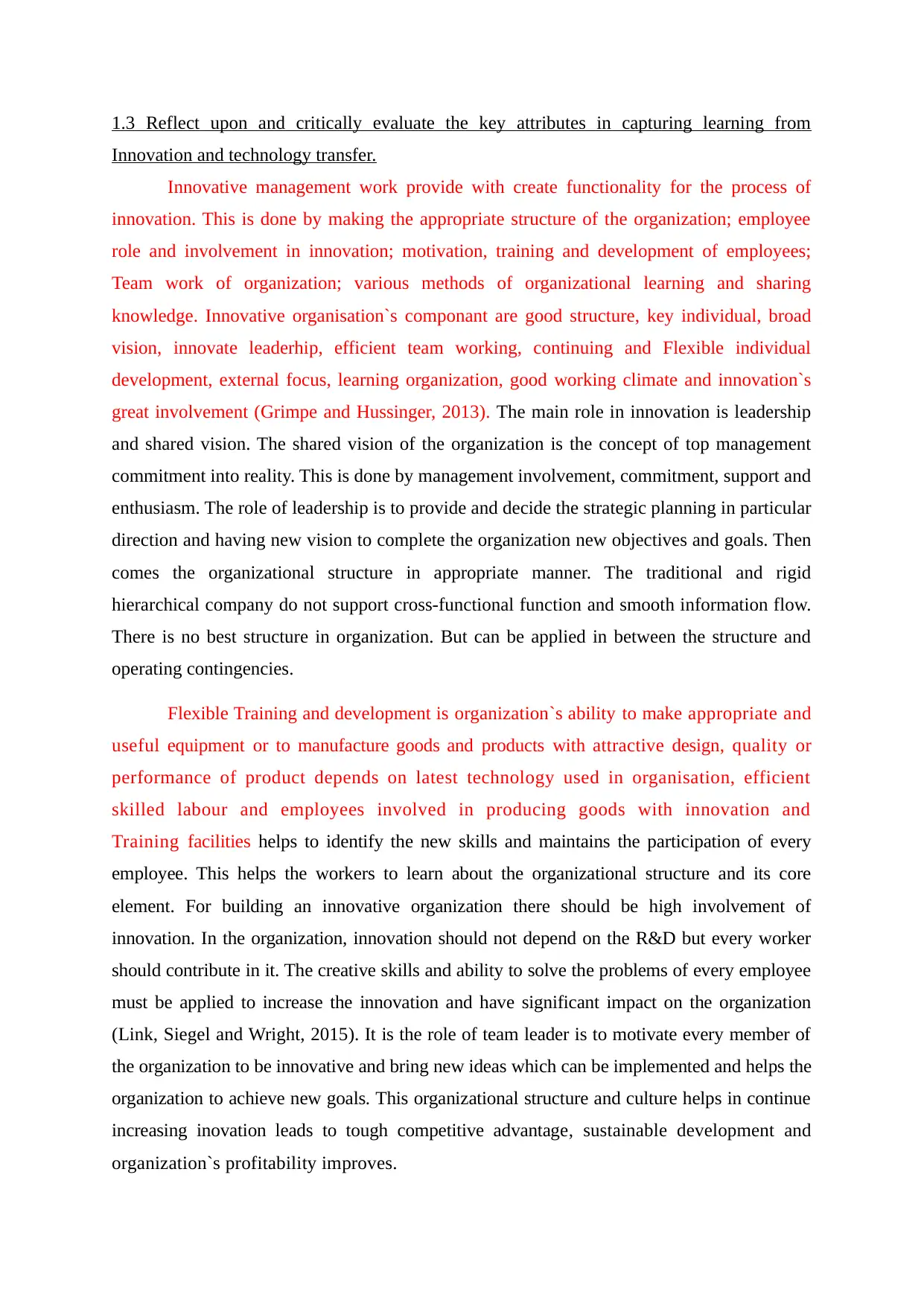
1.3 Reflect upon and critically evaluate the key attributes in capturing learning from
Innovation and technology transfer.
Innovative management work provide with create functionality for the process of
innovation. This is done by making the appropriate structure of the organization; employee
role and involvement in innovation; motivation, training and development of employees;
Team work of organization; various methods of organizational learning and sharing
knowledge. Innovative organisation`s componant are good structure, key individual, broad
vision, innovate leaderhip, efficient team working, continuing and Flexible individual
development, external focus, learning organization, good working climate and innovation`s
great involvement (Grimpe and Hussinger, 2013). The main role in innovation is leadership
and shared vision. The shared vision of the organization is the concept of top management
commitment into reality. This is done by management involvement, commitment, support and
enthusiasm. The role of leadership is to provide and decide the strategic planning in particular
direction and having new vision to complete the organization new objectives and goals. Then
comes the organizational structure in appropriate manner. The traditional and rigid
hierarchical company do not support cross-functional function and smooth information flow.
There is no best structure in organization. But can be applied in between the structure and
operating contingencies.
Flexible Training and development is organization`s ability to make appropriate and
useful equipment or to manufacture goods and products with attractive design, quality or
performance of product depends on latest technology used in organisation, efficient
skilled labour and employees involved in producing goods with innovation and
Training facilities helps to identify the new skills and maintains the participation of every
employee. This helps the workers to learn about the organizational structure and its core
element. For building an innovative organization there should be high involvement of
innovation. In the organization, innovation should not depend on the R&D but every worker
should contribute in it. The creative skills and ability to solve the problems of every employee
must be applied to increase the innovation and have significant impact on the organization
(Link, Siegel and Wright, 2015 ). It is the role of team leader is to motivate every member of
the organization to be innovative and bring new ideas which can be implemented and helps the
organization to achieve new goals. This organizational structure and culture helps in continue
increasing inovation leads to tough competitive advantage, sustainable development and
organization`s profitability improves.
Innovation and technology transfer.
Innovative management work provide with create functionality for the process of
innovation. This is done by making the appropriate structure of the organization; employee
role and involvement in innovation; motivation, training and development of employees;
Team work of organization; various methods of organizational learning and sharing
knowledge. Innovative organisation`s componant are good structure, key individual, broad
vision, innovate leaderhip, efficient team working, continuing and Flexible individual
development, external focus, learning organization, good working climate and innovation`s
great involvement (Grimpe and Hussinger, 2013). The main role in innovation is leadership
and shared vision. The shared vision of the organization is the concept of top management
commitment into reality. This is done by management involvement, commitment, support and
enthusiasm. The role of leadership is to provide and decide the strategic planning in particular
direction and having new vision to complete the organization new objectives and goals. Then
comes the organizational structure in appropriate manner. The traditional and rigid
hierarchical company do not support cross-functional function and smooth information flow.
There is no best structure in organization. But can be applied in between the structure and
operating contingencies.
Flexible Training and development is organization`s ability to make appropriate and
useful equipment or to manufacture goods and products with attractive design, quality or
performance of product depends on latest technology used in organisation, efficient
skilled labour and employees involved in producing goods with innovation and
Training facilities helps to identify the new skills and maintains the participation of every
employee. This helps the workers to learn about the organizational structure and its core
element. For building an innovative organization there should be high involvement of
innovation. In the organization, innovation should not depend on the R&D but every worker
should contribute in it. The creative skills and ability to solve the problems of every employee
must be applied to increase the innovation and have significant impact on the organization
(Link, Siegel and Wright, 2015 ). It is the role of team leader is to motivate every member of
the organization to be innovative and bring new ideas which can be implemented and helps the
organization to achieve new goals. This organizational structure and culture helps in continue
increasing inovation leads to tough competitive advantage, sustainable development and
organization`s profitability improves.
⊘ This is a preview!⊘
Do you want full access?
Subscribe today to unlock all pages.

Trusted by 1+ million students worldwide
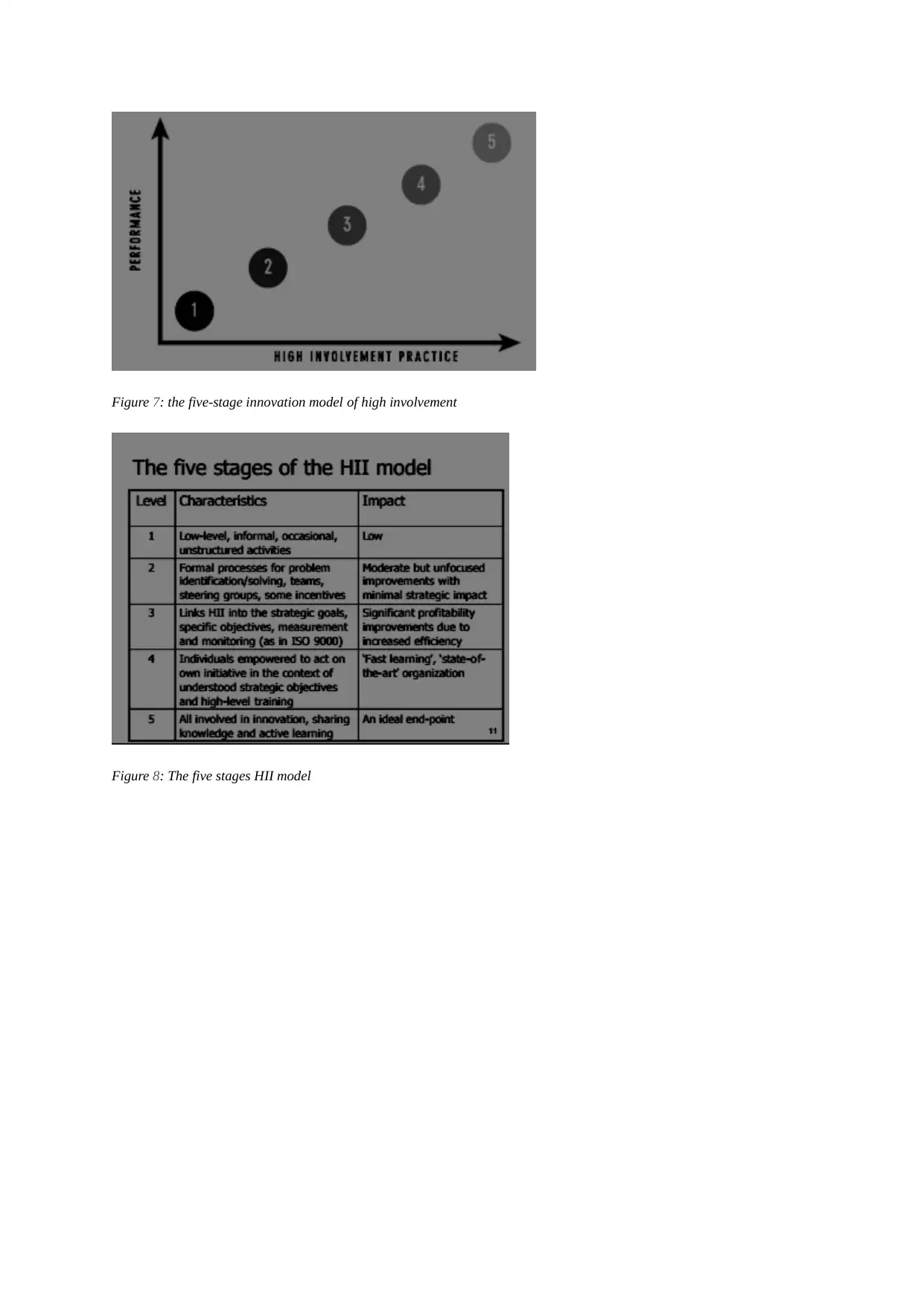
Figure 7: the five-stage innovation model of high involvement
Figure 8: The five stages HII model
Figure 8: The five stages HII model
Paraphrase This Document
Need a fresh take? Get an instant paraphrase of this document with our AI Paraphraser
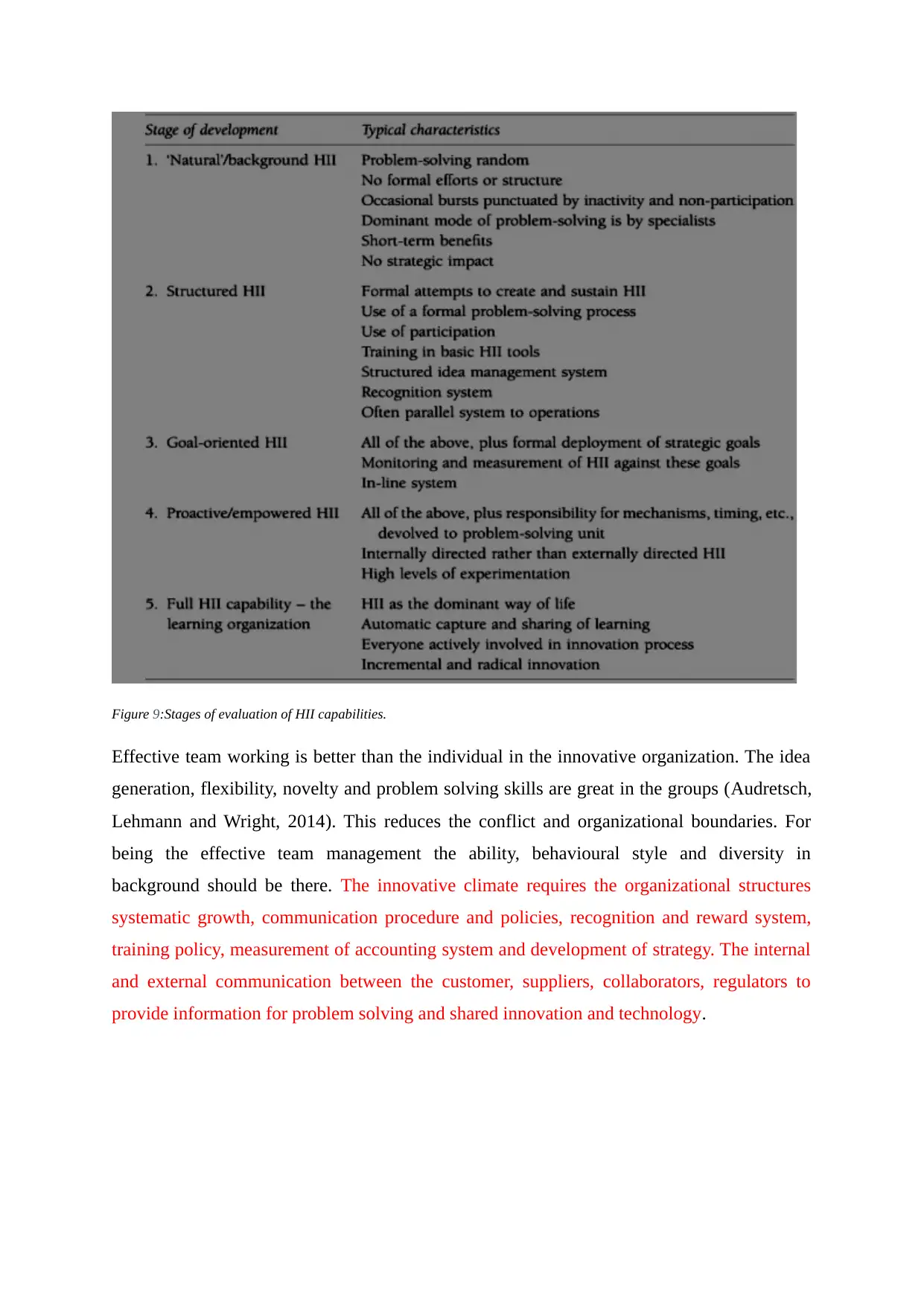
Figure 9:Stages of evaluation of HII capabilities.
Effective team working is better than the individual in the innovative organization. The idea
generation, flexibility, novelty and problem solving skills are great in the groups (Audretsch,
Lehmann and Wright, 2014). This reduces the conflict and organizational boundaries. For
being the effective team management the ability, behavioural style and diversity in
background should be there. The innovative climate requires the organizational structures
systematic growth, communication procedure and policies, recognition and reward system,
training policy, measurement of accounting system and development of strategy. The internal
and external communication between the customer, suppliers, collaborators, regulators to
provide information for problem solving and shared innovation and technology.
Effective team working is better than the individual in the innovative organization. The idea
generation, flexibility, novelty and problem solving skills are great in the groups (Audretsch,
Lehmann and Wright, 2014). This reduces the conflict and organizational boundaries. For
being the effective team management the ability, behavioural style and diversity in
background should be there. The innovative climate requires the organizational structures
systematic growth, communication procedure and policies, recognition and reward system,
training policy, measurement of accounting system and development of strategy. The internal
and external communication between the customer, suppliers, collaborators, regulators to
provide information for problem solving and shared innovation and technology.
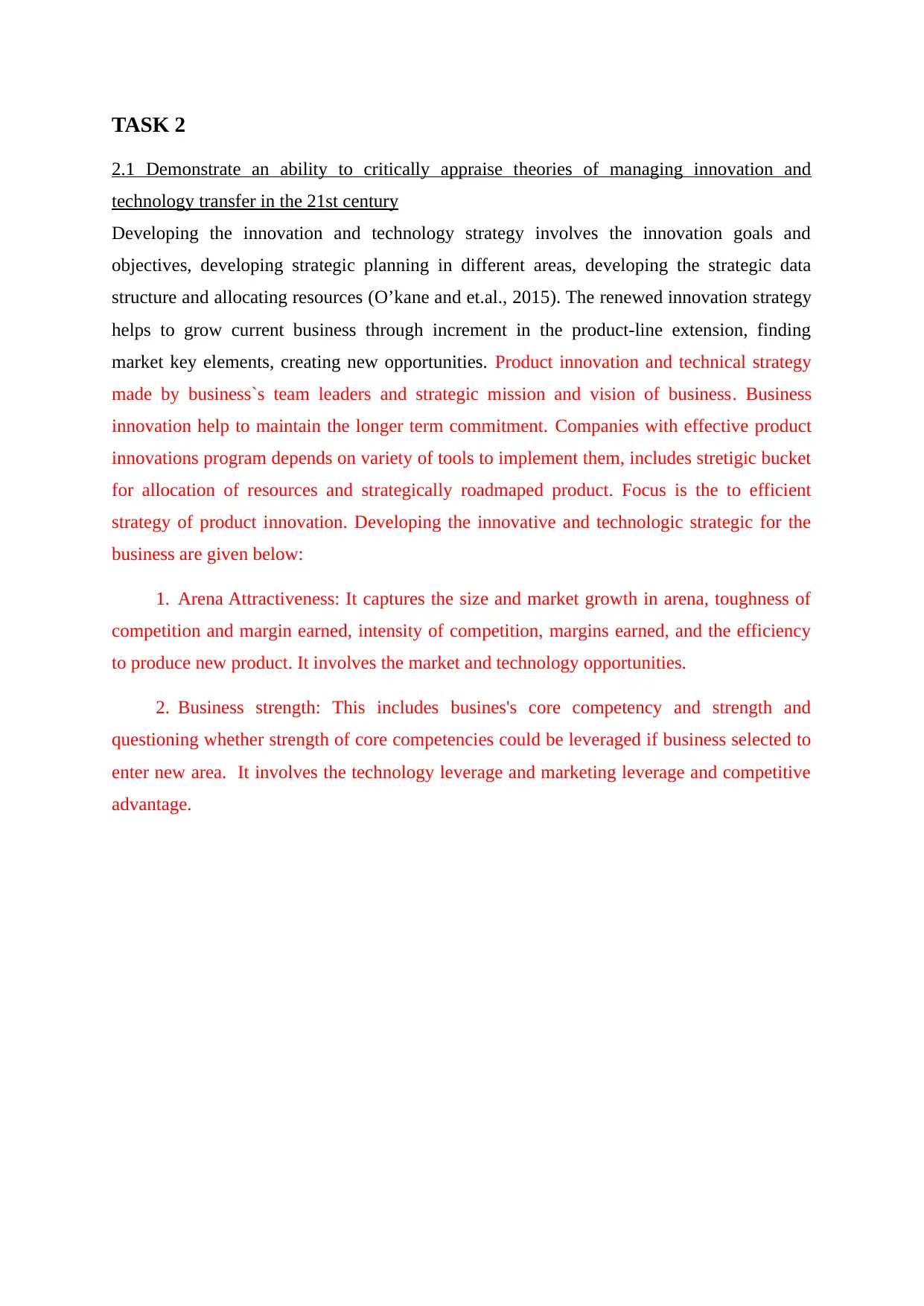
TASK 2
2.1 Demonstrate an ability to critically appraise theories of managing innovation and
technology transfer in the 21st century
Developing the innovation and technology strategy involves the innovation goals and
objectives, developing strategic planning in different areas, developing the strategic data
structure and allocating resources (O’kane and et.al., 2015). The renewed innovation strategy
helps to grow current business through increment in the product-line extension, finding
market key elements, creating new opportunities. Product innovation and technical strategy
made by business`s team leaders and strategic mission and vision of business. Business
innovation help to maintain the longer term commitment. Companies with effective product
innovations program depends on variety of tools to implement them, includes stretigic bucket
for allocation of resources and strategically roadmaped product. Focus is the to efficient
strategy of product innovation. Developing the innovative and technologic strategic for the
business are given below:
1. Arena Attractiveness: It captures the size and market growth in arena, toughness of
competition and margin earned, intensity of competition, margins earned, and the efficiency
to produce new product. It involves the market and technology opportunities.
2. Business strength: This includes busines's core competency and strength and
questioning whether strength of core competencies could be leveraged if business selected to
enter new area. It involves the technology leverage and marketing leverage and competitive
advantage.
2.1 Demonstrate an ability to critically appraise theories of managing innovation and
technology transfer in the 21st century
Developing the innovation and technology strategy involves the innovation goals and
objectives, developing strategic planning in different areas, developing the strategic data
structure and allocating resources (O’kane and et.al., 2015). The renewed innovation strategy
helps to grow current business through increment in the product-line extension, finding
market key elements, creating new opportunities. Product innovation and technical strategy
made by business`s team leaders and strategic mission and vision of business. Business
innovation help to maintain the longer term commitment. Companies with effective product
innovations program depends on variety of tools to implement them, includes stretigic bucket
for allocation of resources and strategically roadmaped product. Focus is the to efficient
strategy of product innovation. Developing the innovative and technologic strategic for the
business are given below:
1. Arena Attractiveness: It captures the size and market growth in arena, toughness of
competition and margin earned, intensity of competition, margins earned, and the efficiency
to produce new product. It involves the market and technology opportunities.
2. Business strength: This includes busines's core competency and strength and
questioning whether strength of core competencies could be leveraged if business selected to
enter new area. It involves the technology leverage and marketing leverage and competitive
advantage.
⊘ This is a preview!⊘
Do you want full access?
Subscribe today to unlock all pages.

Trusted by 1+ million students worldwide
1 out of 23
Related Documents
Your All-in-One AI-Powered Toolkit for Academic Success.
+13062052269
info@desklib.com
Available 24*7 on WhatsApp / Email
![[object Object]](/_next/static/media/star-bottom.7253800d.svg)
Unlock your academic potential
Copyright © 2020–2025 A2Z Services. All Rights Reserved. Developed and managed by ZUCOL.





